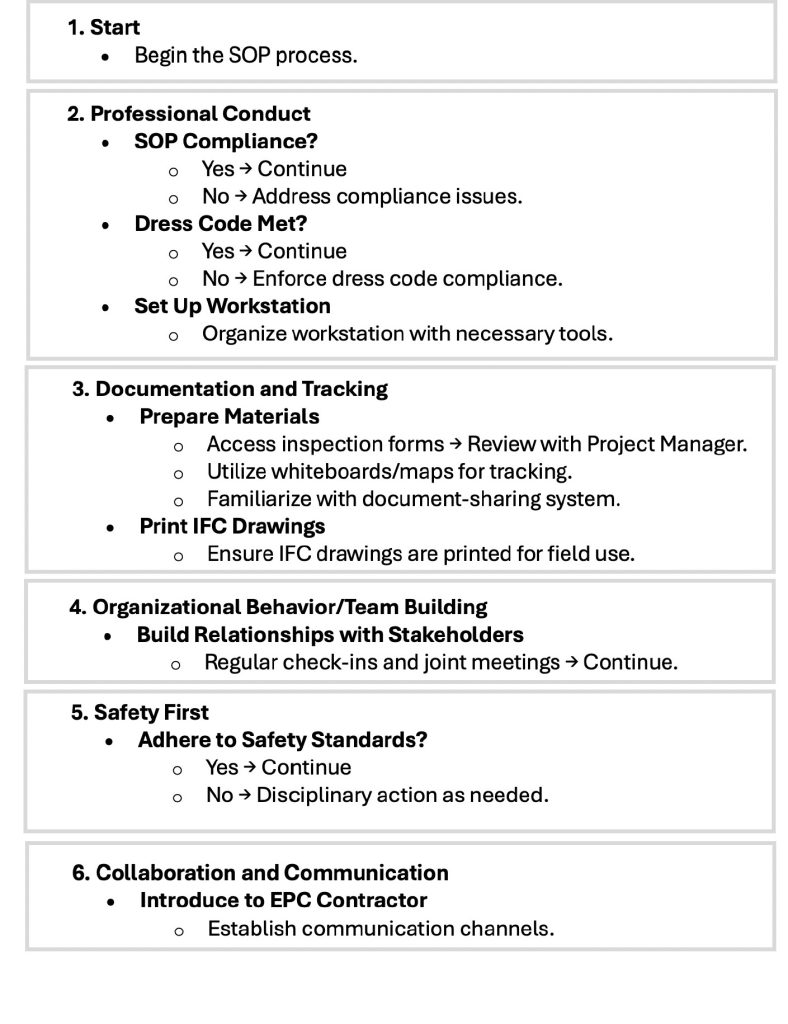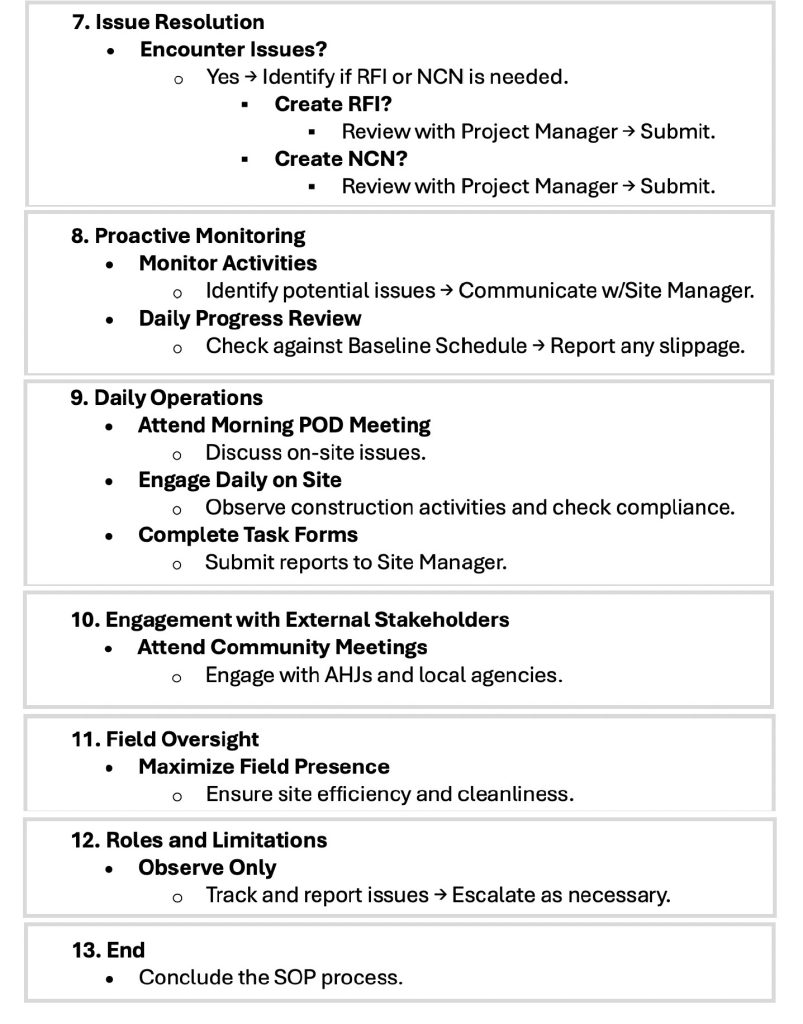Purpose
This SOP outlines the roles, responsibilities, and operational protocols for our Owner’s Representative (OR) construction site team members. Its primary aim is to ensure efficient site management, compliance with contract specifications, and effective communication throughout the construction process. By following this SOP, we strive to mitigate risks and ensure that our Client’s energy infrastructure projects are completed safely, on time, and within budget.
Functional Roles
Our OR teams comprise various professional roles, each bringing specialized expertise to the project:
- Site Managers: Oversee day-to-day operations and ensure site activities align with project goals.
- MV Electrical Superintendents: Focus on medium-voltage electrical systems and their installation.
- HV Electrical Superintendents: Manage high-voltage electrical systems, ensuring compliance with safety standards.
- Civil/Mechanical Superintendents: Oversee civil and mechanical construction aspects, ensuring proper execution.
- Mechanical Superintendents: Specialize in mechanical systems installation and maintenance.
- Project Construction Coordinators: Administrative duties including facilitating communication between teams and manage schedules.
- Safety Specialists: Ensure adherence to safety regulations and promote a safe work environment.
- Community Liaison Officers: Act as a bridge between the project and the surrounding community, addressing concerns and fostering positive relationships.
- Additional roles as defined by the Client.
Professional Conduct
- SOP Compliance: All ORs are required to comply with the standards set forth in our Employee Handbook, which outlines our Standard Operating Procedures (SOP) and best practices. Each employee has signed a commitment to uphold these standards during their onboarding process.
- Dress Code: ORs must arrive on-site in professional attire that reflects the seriousness of their role. This includes appropriate safety attire and Personal Protective Equipment (PPE) based on specific job functions.
- Workstation Setup: Upon arrival, each representative will establish their workstation within the owner’s construction site trailers. Workstations should be organized and equipped with the necessary tools and materials to fulfill their functional roles and daily activities efficiently.
Documentation and Tracking
Preparation of Materials:
- Each OR will arrive on-site with access to over 100 proprietary inspection forms and checklists curated internally. Before using any inspection form or checklist, the OR shall review it with the Project Manager to ensure all Client specifications are captured within.
- ORs will utilize whiteboards and print enlarged maps and single-line drawings to facilitate daily status updates and track site activities.
- ORs must ensure that appropriate tracking and documentation for completed tasks and ongoing work locations are communicated to the appropriate parties, enabling accurate reporting to the Project Manager.
- Each OR will familiarize themselves with the Client’s preferred document-sharing system and project management platform, adhering to Client processes when sharing information and documents.
- ORs are required to be equipped with appropriate Personal Protective Equipment (PPE) before arriving on-site. This ensures that each team member is prepared to maintain safety standards and comply with the Client’s and EPC’s Safety Requirements while on the Client’s premises.
Printing IFC Drawings:
- ORs will print Issued for Construction (IFC) drawings for use in the field. These documents provide real-time reference during site inspections and daily operations.
Organizational Behaviour / Team Building
Building and Maintaining Relationships with Stakeholders
- Effective collaboration and relationship-building are fundamental to the success of our Clients’ projects. OR team members must actively cultivate and maintain strong relationships with the EPC teams, AHJs, and other key stakeholders throughout the project lifecycle.
- OR should leverage relationships to facilitate timely issue resolution and proactive community engagement to mitigate issues and conflicts that pose a hinderance to the safe and successful completion of the work.
- All OR team members are encouraged to prioritize relationship-building efforts through regular check-ins, participation in joint meetings, and open lines of communication. By investing in these relationships, we enhance our ability to navigate challenges, leverage collective expertise, and ensure the successful delivery of our Client’s energy infrastructure projects.
Safety First
At our organization, we prioritize “safety first” and expect all employees to actively promote a safe workplace. Adherence to safety requirements is not just encouraged; it is a fundamental condition of employment and will be assessed as part of each employee’s overall performance evaluation.
We are committed to providing a clean, hazard-free, and healthy work environment. To achieve this, we strive to comply with all applicable federal, state, and local occupational health and safety regulations, including the Occupational Safety and Health Act (OSHA) and the Mine Safety and Health Administration (MSHA) standards.
Given the critical nature of safety, employees who violate safety standards, create hazardous situations, or neglect to address conditions that can be effectively resolved may face disciplinary actions, which can include termination.
While on the Client’s premises, OR teams must adhere to all reasonable requests, standard rules, and regulations established by the Client and full compliance with the Client’s and EPC’s Safety Requirements. A copy of these Safety Requirements, along with any updates, will be provided to all ORs to ensure they are informed and equipped to uphold these standards.
By fostering a culture of safety, we ensure the well-being of all employees and the success of our projects.
Collaboration and Communication
Introduction to EPC Contractor:
- Each OR is required to introduce themselves to the EPC contractor and their counterparts to establish effective communication channels and foster collaborative relationships.
Issue Resolution
Request for Information (RFI):
- If conflicts with the IFCs arise, the OR will request the Site Manager to create an RFI for clarification from the EPC contractor. The Site Manager must review the RFI with the Project Manager before submission to ensure alignment with Client preferences. All ORs have been equipped with standardized RFI templates.
Non-Conformance Notice (NCN):
- If IFCs or best practices are not being followed, the OR will work with the Site Manager to draft an NCN to document the infraction. The Site Manager must review the NCN with the Project Manager prior to submission to the EPC contractor. All ORs have been equipped with standardized NCN templates.
Proactive Monitoring
Anticipating Issues:
- ORs must actively monitor the contractor’s activities to identify potential issues that could impede progress and communicate these proactively to the Site Manager.
Progress Review:
- Conduct daily reviews of activities against the Baseline Schedule. Any detected slippage must be reported to the Site Manager promptly, who will escalate the issue to the Project Manager regarding potential schedule impacts.
Daily Operations
Morning POD Attendance:
- All Owner’s Representatives must attend the Project Operations Daily (POD) meetings to discuss on-site issues and facilitate prompt resolutions.
Daily Site Engagement:
- ORs must spend the majority of their time observing construction activities in the field, ensuring compliance with IFCs and the application of industry best practices.
- Implement regular check-ins with EPC counterparts to discuss progress, challenges, and alignment with project objectives.
Task Forms and Reporting:
- Complete task forms for all completed work and provide the Site Manager with detailed reports of site activities. Depending on Client preferences, these reports may be compiled by the Site Manager for daily, weekly, or monthly presentations to the Project Manager and other assigned representatives.
Engagement with External Stakeholders
Community and Agency Meetings:
- The Site Manager is responsible for attending County Commissioner meetings and engaging with state agencies and other Authorities Having Jurisdiction (AHJs). With Client consent, participation in community engagement activities is encouraged to foster good relations and maintain open communication with stakeholders.
Field Oversight
Field Presence:
- The Site Manager should maximize time spent in the field to ensure the site is clean, organized, and operationally efficient while closely monitoring the project schedule.
Roles and Limitations
Observer Role:
- The Owner’s Representative teams serve strictly in an observational capacity and are not permitted to direct work on-site. Their role is to track, report, and facilitate communication. If issues cannot be resolved through discussion or email, concerns must be escalated through formal RFIs or NCNs.
Conclusion
This Standard Operating Procedure (SOP) serves as a detailed framework for the Owner’s Representative construction site team. By defining roles, responsibilities, and operational protocols, we aim to enhance site management and facilitate effective communication.
Adhering to these guidelines is essential for meeting contractual obligations and ensuring the safety and efficiency of our assigned construction projects.
By following this SOP, all team members play a crucial role in the successful execution of our Client’s energy infrastructure projects, helping to achieve timely and budget-compliant results. Commitment to continuous improvement and adherence to these practices is vital for cultivating a culture of safety and excellence within our organization.
SOP Summary





